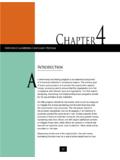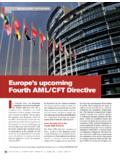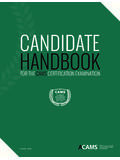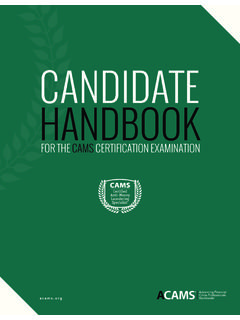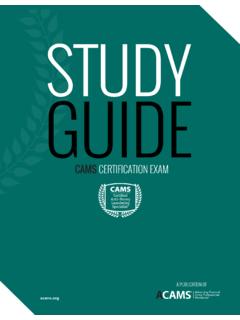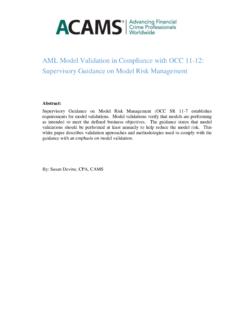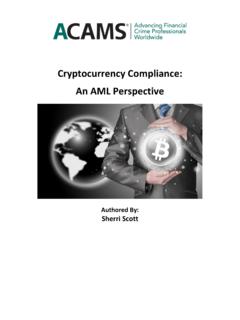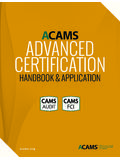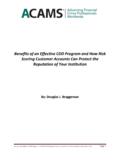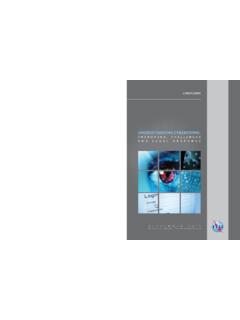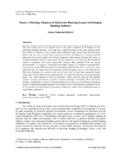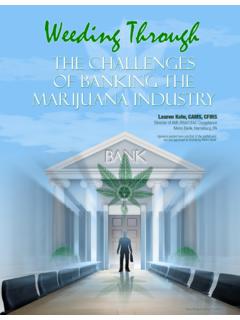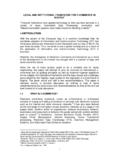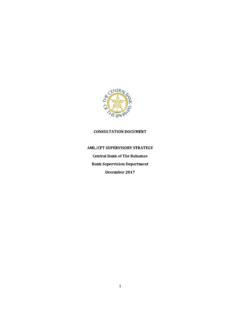Transcription of Ultimate Beneficial Owners (UBO) Between Identification ...
1 Ultimate Beneficial Owners (UBO). Between Identification and Verification By: Alaa Saleh Ghaith Contents I. Executive Summary .. 2. II. Methods of Identification and Verification for UBOs .. 3. A. Possible UBOs of Common Types of Account Holders .. 3. B. The Methodology of Identifying and Verifying UBO .. 4. III. The Importance of Compliance with UBO's Requirements .. 5. A. The Grounds of Regulations Imposing the Obligation of Identifying UBO .. 5. B. Consequences of Not Complying with the UBO 6. IV. Challenges of Identifying and Verifying UBO .. 6. A. Identifying and Verifying UBOs.. 6. B. Observations on the Current Audit Process of UBO .. 7. C. Lack of Independent Testing to Comply to UBO Policy and Procedures .. 7. V. Identify Effective Policy, Procedures and Controls to Identify and Verify the UBO.
2 8. A. Risk Assessment .. 8. B. Developing and Implementing Effective Policy and 8. C. Creating Core System 9. D. Matrix of KYC Requirements .. 10. E. Qualification and Knowledge .. 10. F. Other Controls for Identifying and Verifying the 11. VII. 13. I. Glossary of Defined Terms .. 14. 1|P a ge I. Executive Summary Establishing effective policy and processes to identify an Ultimate Beneficial owner (UBO) is essential in combating money laundering and terrorist financing. All UBOs should be identified, declared, verified (where applicable) for all new and changes to existing accountholder accounts and financial services and products provided to occasional (walk-in) accountholders. These procedures must require proper due diligence and may identify unusual transactions, and possibly report the suspicious transactions.
3 International AML standards and regulations ( , the Financial Action Task Force [FATF] Recommendations, the Financial Crimes Enforcement Network [FinCEN] and the Basel Committee principles), and local regulatory requirements impose legal and regulatory obligations on financial institutions (FIs) to identify UBOs, these obligations will be discussed in this white paper. FATF defines1 UBOs as natural person(s) who ultimately owns or controls an accountholder and/or the person on whose behalf a transaction is being conducted. It also incorporates those persons who exercise Ultimate effective control over a legal person or arrangement. (1) Reference to ultimately owns or controls and Ultimate effective control refer to situations in which ownership/control is exercised through a chain of ownership or by means of control other than direct control.
4 (2) This definition should also apply to a Beneficial owner of a life or other investment linked insurance policy. Money launders, terrorists and sanctioned parties try to access the financial system by hiding their existence ( , true identity) during account opening and service request processes, through using individual or non-individual accounts opened by their association's or family members' names, or opening accounts for legal entities with complex ownership structure, or any other tactics to avoid detection. UBO Identification and verification can be very difficult due to a lot of challenges, for example: 1. Complex ownership structures of the legal entities 2. Legal entities established in high secrecy jurisdiction ( , Samoa, Cayman Islands, Panama).
5 3. False accountholder's declarations on UBOs 4. Limited information available on offshore accountholders 5. Unqualified staff FIs have the Ultimate responsibility to identify UBOs and verify them (where applicable). It is worth to mention that UBO verification for individual accounts is not possible in most cases, as FI's depend on the accountholder's declaration only. On the other hand, FIs could be verified the 1 Source: Glossary of the FATF Recommendations ( ). 2|P a ge identified UBO for non-individual accountholders, through reviewing the client's know your customer (KYC) documentation. Therefore, appropriate policy, procedures and controls must be established to comply and mitigate the legal, compliance and regulatory risks.
6 The methodologies of identifying UBOs vary among FIs. Some identify UBOs through obtaining a Declaration Form specifying the UBO and signed by the accountholder. Others verify the UBO through obtaining formal documents that identify the UBO. II. Methods of Identification and Verification for UBOs A. Possible UBOs of Common Types of Accountholders Possible UBOs of common types of individual and non-individual accountholders (legal entities/arrangement) could be identified in detailed in the table below. Accountholder Account Type Possible UBO. Classification Adult Accountholder Account party Adult Accountholder Account Individual of Attorney (POA) holder opened through Power of Attorney party 2. (POA). Minor Accountholder Account 1.
7 Guardian opened by Guardian party 1. Shareholder 2. Directors Corporate Account 3. Authorized Signatory 4. Financial Control Officer (FCO). 5. Third party 1. Shareholder if any . 2. Directors/trustee 3. Authorized Signatory Non-profit Organization/Charity Non-individuals Control Officer (FCO). Account 5. Provider of materiel funds/allowances 6. Third party of funds 2. Directors 3. Principal Underwriter/Sponsor Mutual Fund 4. Administrator 6. Custodian 7. Third party 1. Directors/trustees Governmental/Official Authorities 2. Authorized Signatory Account party 2 Third party: anyone that has direct/indirect control over the account holder 3|P a ge B. The Identification and verification process for UBOs should be performed during account opening, while updating KYC information, when obtaining banking services/products forms.
8 Policy, procedures and processes must clearly ask the accountholder to declare the UBO, with imposing an obligation on the accountholder to update the FI, if the declared UBO is changed. The following must be obtained, before providing the financial service, activating the account, or issuing banking self-services to the accountholder for individual and non-individual accounts: 1. Reason of having a third party as a UBO and the relationship Between the accountholder and the declared UBO. 2. Full KYC documentation and information (full name, nationality, resident address, source of funds/wealth, etc.). 3. If the accountholder is a citizen of the , it is required that they complete the appropriate form, to comply with Foreign Account Tax Compliance Act (FATCA).
9 Requirements, for individual accounts only. UBO verification can be conducted through several different ways, as explained in Figure 1. Figure 1 Verifying UBO. The above methodology may differ Between institutions and accountholder types, but the UBO. must be clearly identified and verified by the FI as an essential part of KYC requirements. 4|P a ge III. The Importance of Compliance with UBO Requirements A. The grounds of regulations imposing the obligation of identifying UBOs is addressed in various manners by the Department of the Treasury of the , Money Laundering Regulations 2007, the European Commission, 3 FATF Recommendations and the Basel Committee's customer due diligence (CDD) paper. These are all summarized as: 1. Sections 325 and 326 of the USA Patriot Act 2001, 4 issued by Department of the Treasury of the , requests FIs to take additional steps to identity UBOs of the accountholder by seeking information about individuals with ownership or control over the account, and verify The text of related it.
10 Regulations and laws are 2. Money Laundering Regulations 2007, 5 regulation numbers different and not and (2) requires FIs to identify and verify Beneficial identical, but the Owners when it: A) Establishes a business relation; B) Carries out an occasional transaction (which is defined as a transaction outside of objective is one, by a business relationship amounting to EUR 15,000 or more, whether driving FI to identify the the transaction is carried out in a single operation or several UBO, and verify it in operations which appear to be linked); C) Suspects money applicable cases laundering or terrorist financing; D) Doubts the veracity or adequacy of documents, data or information previously obtained for the purposes of Identification or verification.
